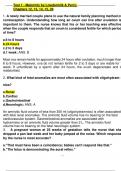Exam (elaborations)
Test bank for maternity and womens health care 12th edition (lowdermilk ) all chapters complete questions and answers a+.
- Course
- Institution
Test bank for maternity and womens health care 12th edition (lowdermilk ) all chapters complete questions and answers a+.
[Show more]












